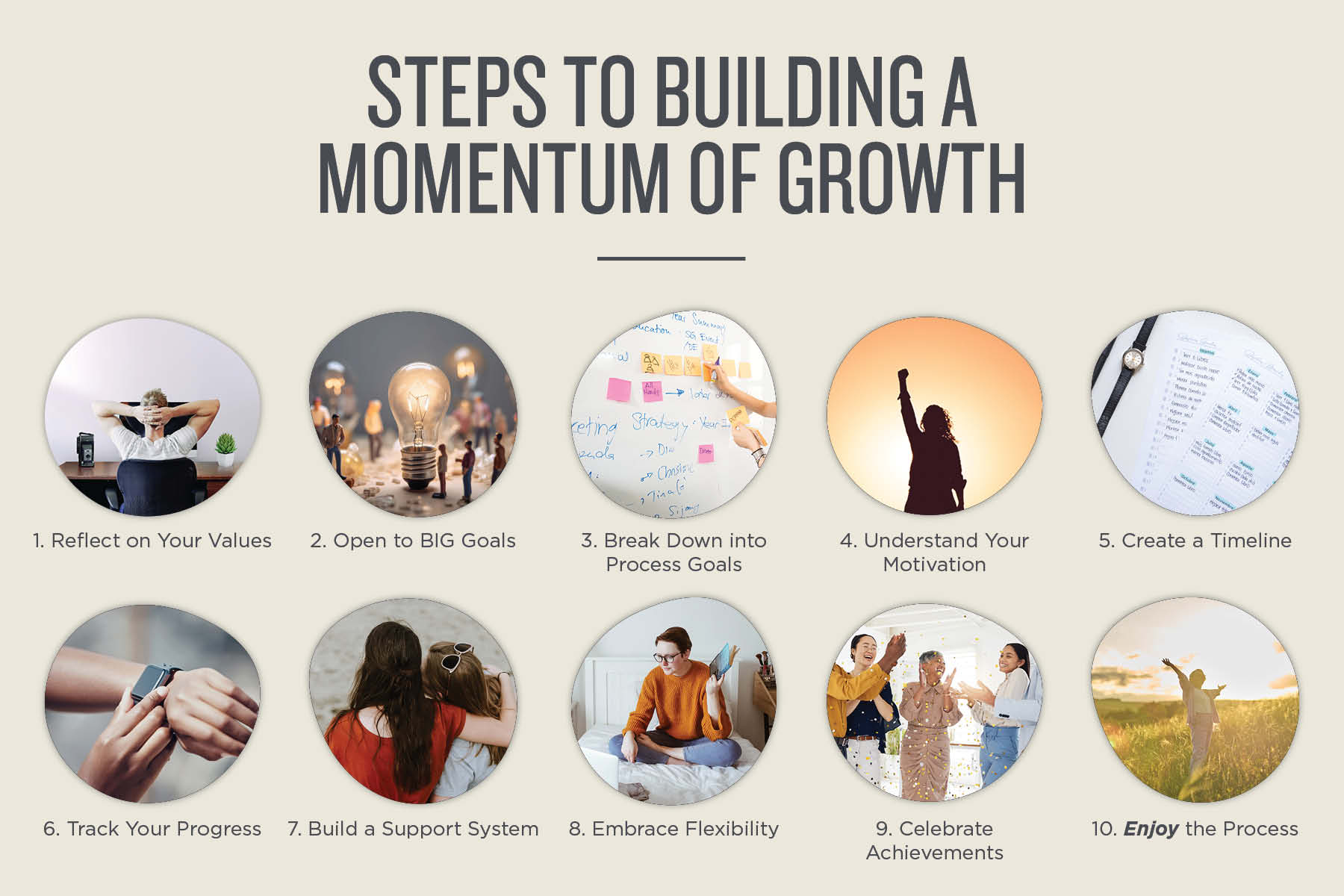Navigating Wonderland
In Lewis Carroll’s timeless tale, “Alice in Wonderland,” Alice finds herself at a crossroads, uncertain of the path to take. In her confusion, she encounters the Cheshire Cat, who wisely advises her that it doesn’t matter which road she chooses if she doesn’t know where she is going. This whimsical encounter serves as a profound metaphor for the journey many embark upon when opening to change. Just like Alice, we can be overwhelmed without goals providing direction and purpose in our growth journey. However, goals alone cannot provide a vessel for growth. Let’s explore Four Keys (goals, plans, motivation and commitment) to help guide us through the wonderland of wellness.
Wonder: Where It All Begins
In goal setting, the common advice is to begin by defining what you want to achieve and who you aim to become in some distant future. However, based on my 20 years as a high-performance coach, I’ve observed that this may not be the most effective initial step. Like a plant aiming for height invests energy in establishing a taproot and root system, the first focus should be on building a foundation in fertile ground to sustain growth.
A minor misalignment in measurements may not matter for a two-inch task, but in a project spanning miles, it can lead to a significant deviation. Similarly, setting goals from a misaligned state may distance you from your true self, even if the desired outcome is achieved.
I recommend starting your goal-setting process by turning inwards with self-reflection in a state of wonder. Wonder opens us to the unknown and that is where our dormant potential resides. You can engage in this self-reflective wonder process by asking expansive questions like “Who am I now?” “What is important to me?” “What are my values and principles?” “What makes my heart sing?” “What am I most afraid of?” and so on. By turning inwards, we have a better chance of creating goals from a place of resourced grounding and we can goal select (rather than goal set) more clearly with an open accepting, and supportive mindset.
In Taoism, “making the path the goal” suggests planting seeds of happiness, growth, or fulfillment in the present. While ambitious dreams guide the process, it’s vital to enjoy the journey toward realization as a process of discovery and celebration. This contrasts with the mindset of “more is better but never enough” or the belief that achieving a goal will magically bring happiness, contentment, fulfillment, or worthiness.
Accept Now…and Grow
You have the choice to approach your known potential by accepting your current situation or by deeming your current state inadequate compared to your potential. The former fosters energy and a supportive attitude, while the latter drains energy and generates unsupportive moods. In challenging situations like an unsupportive relationship, chronic stress, or resource shortages, you might question why you should accept the circumstances. Whether your life is challenging or fantastic, rejecting it adds noise, extra work, and more obstacles to freeing yourself. Accepting your life as it is, on the other hand, minimizes unnecessary stress and liberates the resources you do have to foster supportive growth. The suggestion is not to accept your life and become complacent but to accept it and grow.
The Four-Keys: Goals-Plans-Motivation-Commitment
I have personally witnessed many people, despite following conventional goal-setting advice, end up stuck in inertia because they neglected to nurture the foundational soil essential for their growth. It’s crucial to invest time in cultivating this soil before reaching for the heights of self-expression.
After tending to your soil through self-reflection and maintaining a state of wonder, I suggest employing what I refer to as “The Four Keys” as a tool to guide the growth momentum. These keys encompass goals, plans, motivation, and commitment. Let’s delve into each element and explore how they collaboratively form a powerful support system for your personal development.
Key #1: Goals (Direction)
Goals serve as desired outcomes that focus and direct our efforts. However, I’m emphasizing the pursuit of substantial goals—BIG goals! After dedicating time to align ourselves through wonder and self-reflection, we become better equipped to broaden our vision and establish ambitious goals.
Setting ambitious, high-hard goals is akin to igniting a spark. stretch the boundaries of comfort and serve as powerful catalysts for growth. They force individuals to confront their limitations, transcend self-imposed boundaries, and tap into reservoirs of untapped potential. In the face of such lofty aspirations, a sense of direction emerges—clear and magnetic—guiding efforts and energy toward the pursuit of self-discovery and personal growth.
Key #2: Plans (Focus)
While overarching goals provide a sense of direction, breaking them down into smaller, actionable steps known as process goals or clear goals is essential. Process goals serve as the building blocks that pave the way for significant achievements. High-hard goals are great but because they exist far in the future and far from your current ability level on their own, they can be a distraction. Instead of fixating solely on the destination and the desired outcome, creating clear process goals helps to actually focus on the present moment and facilitates progress.
In Atomic Habits, James Clear says that research has shown that you are 2x to 3x more likely to stick to your goals if you make a specific plan for when, where, and how you will perform the behaviour. For instance, if the ultimate goal is to lose weight, the process goals could include weekly meal prepping, increasing daily steps, or attending fitness classes regularly. These smaller, manageable steps not only make the larger goal more achievable but also provide a sense of accomplishment along the way.
Having established high-hard goals, and clear process goals using the mental focusing queue of “What now?…What next? Helps stay focused throughout our day and in doing so we link moment-to-moment focus which builds momentum.
Key #3: Motivation (Fuel)
‘Motive’ means reason, and ‘ation’ is action. So, motivation is your reason to take action. There are two main forms of motivation, intrinsic, and extrinsic.
When people say long-term goals give you motivation, this can be true, but it gives a specific type of motivation, extrinsic motivation, or results-driven motivation. This form of motivation is powerful but is a limited resource. I like to think of it as paying for something with credit. You paid for it, but the transaction isn’t complete. Intrinsic motivation on the other hand is doing something without any obvious external rewards, you do what you do primarily because it’s enjoyable and interesting. Intrinsic motivation is a limitless resource and is like paying for something with cash in hand.
Although we will need to draw from both extrinsic and intrinsic motivation in the pursuit of big goals it is essential to align with intrinsic motivation to avoid overwhelm and burnout. Ask yourself why the goals you’ve identified matter to you. Whether it’s improving energy levels, opening up to new challenges, or simply feeling more confident, identifying your motivations will serve as a powerful driving force during moments of challenge.
Key #4: Commitment (Strength)
In the field of performance psychology, the number one element common amongst high performers is not talent, resources, or confidence, it is commitment. People with all varieties of backgrounds, levels of support, and innate talents have expanded human abilities through the ability to commit deeply to effectively face challenges, put in the effort, and endure the pain and discomfort inherent in making change.
Setting goals is just the beginning, you could set a high-hard goal say to win an Olympic medal, write a best-selling book, or run a marathon and that huge goal would stay unchanged until it is realized or until the opportunity has passed. However, commitment is something that needs to be refreshed and proven every-single-day! The journey towards realizing a huge goal demands consistent effort, resilience, and a willingness to adapt because if the goal is big enough you will face massive challenges, setbacks, and failures.
Steps to Building a Momentum of Growth and Realizing Your Big Goals
Embarking on a personal growth journey requires intentional steps to transform goals into reality. Here’s a simple guide to help you create, work towards, and ultimately realize your goals:
- Reflect on Your Values: Identify what matters most to you.
- Open to BIG Goals: Enter a state of wonder and use stream of conscious writing sessions through self-reflection.
- Break Down into Process Goals: Establish smaller, actionable steps that are clear and contribute to your overarching goals.
- Understand Your Motivation: Connect with the deeper reasons driving your health aspirations. Which motivations are intrinsic and which are extrinsic?
- Create a Timeline: Set realistic deadlines to track, course correct, and celebrate your progress.
- Track Your Progress: Regularly monitor your advancements. Celebrate small victories and learn from setbacks. Tracking progress not only keeps you motivated but also allows for necessary adjustments to your approach.
- Build a Support System: Share your goals with friends, family, or join a community with similar objectives. A supportive network can provide encouragement, accountability, and valuable insights.
- Embrace Flexibility: Recognize that the path towards your big goals will have unexpected twists and turns. Be adaptable and open to modifying your goals and pathway based on evolving circumstances and insights.
- Celebrate Achievements: Acknowledge and celebrate your successes, no matter how small.
- Enjoy the Process: Make your growth journey enjoyable by incorporating activities you love. Whether it’s trying new recipes, exploring different workout routines, or discovering exciting outdoor activities, find joy in the process.
On their own, big goals can serve as distractions because in their nature they exist in the future. If we fixate on our goals without creating a clear path towards them, we can find ourselves stuck in a state of futurizing a reality we think we want but not aligning our behaviours with the process to realizing our dreams. The journey of self-discovery and personal growth is a continuous process. One that can be a wild and wonderful ride if we cultivate the mindset to accept our current life as it is and grow from that starting point. By using the Four Keys of opening to BIG goals, identifying clear plans, understanding your motivations, and committing to the journey, you’ll find yourself navigating the wonderland of personal growth with purpose and fulfillment.
Ready to embark on a personal growth journey? Download the Four Keys for Creating a Momentum of Growth roadmap and visit the Free Flow Practice website to learn more.



